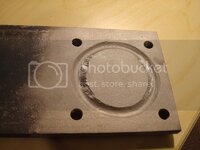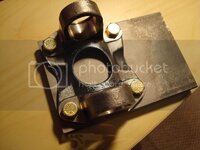You are using an out of date browser. It may not display this or other websites correctly.
You should upgrade or use an alternative browser.
You should upgrade or use an alternative browser.
Rookie's First Restoration Attempt...
- Thread starter stinger12
- Start date
stinger12
Well-known member
- Joined
- Mar 28, 2008
- Messages
- 832
- Reaction score
- 0
Change of plans for the engine, AGAIN:smack My dad doesn't want me pissing away all my money right now on a big block, and it isn't realistic for me. He want's me to rebuild my stock motor to 400 hp, 400 ft/lbs of torque. In 5 or 6 years when I have the money, then I can build myself a big block. ANyways, here's a pic I had of what the chassis looks like now. Still waiting on parts:cheers:


stinger12
Well-known member
- Joined
- Mar 28, 2008
- Messages
- 832
- Reaction score
- 0
Rebuilt some new used half-shafts the past two days. I wasn't happy with my first attempt at installing the u-joints, so I picked up some used shafts at western corvette on Friday. I must have bent my original ones, because I couldn't for the life of me get the spicer u-joints from not binding. Anyways, here's how I did it this time.
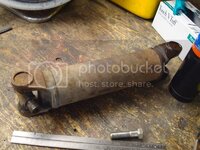
Instead of pressing out the joint and bending the yoke ears, i followed Gary's recommendation. I cut the old joints out using my angle grinder.
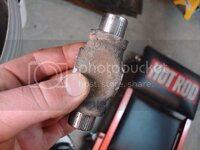
Then I used my propane torch to heat up the outside of the ears. I pooled some PB-blaster in the ears. The point of the heating was to accelerate the PB-blaster into working faster (yes, this trick does work, I've done it numerous times).

After letting the PB-blaster work its magic for a few minutes, I hammered out the caps using a socket and a fairly large hammer...
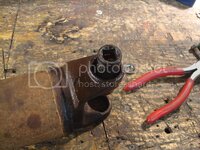
I sandblasted them, wire wheeled, then thoroughly degreased.
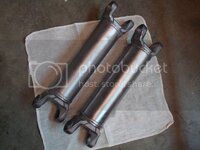
One of the half-shafts I bought came with the extra u-joint flange that I needed. I first cut out the old joints, but I couldn't get the caps out of the bores. I tried absolutely everything. I ended up resorting to my hydraulic press. I used my tool as a backing plate so the flange wouldn't bend. The bottom was still flat after I unbolted it, but the ears were now bent inwards . Then I gave Mike Dyer another call, and he suggested that I try bending it back. I mounted it on my backing plate, then spread the ears apart using this easy to make tool...
. Then I gave Mike Dyer another call, and he suggested that I try bending it back. I mounted it on my backing plate, then spread the ears apart using this easy to make tool...
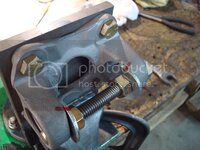
It worked great, way better than expected. The backing plate kept the flange base flat, while the ears were being spread back apart to their original shape. I powder coated the parts and installed the u-joints.

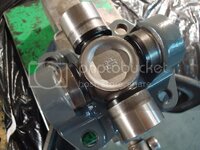
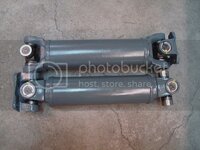

Instead of pressing out the joint and bending the yoke ears, i followed Gary's recommendation. I cut the old joints out using my angle grinder.

Then I used my propane torch to heat up the outside of the ears. I pooled some PB-blaster in the ears. The point of the heating was to accelerate the PB-blaster into working faster (yes, this trick does work, I've done it numerous times).

After letting the PB-blaster work its magic for a few minutes, I hammered out the caps using a socket and a fairly large hammer...

I sandblasted them, wire wheeled, then thoroughly degreased.

One of the half-shafts I bought came with the extra u-joint flange that I needed. I first cut out the old joints, but I couldn't get the caps out of the bores. I tried absolutely everything. I ended up resorting to my hydraulic press. I used my tool as a backing plate so the flange wouldn't bend. The bottom was still flat after I unbolted it, but the ears were now bent inwards

It worked great, way better than expected. The backing plate kept the flange base flat, while the ears were being spread back apart to their original shape. I powder coated the parts and installed the u-joints.



stinger12
Well-known member
- Joined
- Mar 28, 2008
- Messages
- 832
- Reaction score
- 0

Glad you took the time to re-post all this over here........ :thumbs:
I am going to put my son to reading this thread.
Keep it up.........your doing an excellent job. :drink:
Thanks. I forgot to post a link to my rebuild paper...
http://vettemod.com/forum/showthread.php?t=251
stinger12
Well-known member
- Joined
- Mar 28, 2008
- Messages
- 832
- Reaction score
- 0
I'm having real big problems with my offset trailing arms right now - they don't fit, even though my frame pockets are perfect. I'll have to clearance the c-channel a bit on them for extra insurance when I get an alignment done...I don't want these things rubbing the top of the frame pockets. Anyways, here's another project I took on last night. When I was originally reassembling my trailing arms, I didn't think this bearign support ear was going to be an issue. It looks like the strut bushing shell dug into the ear over the past 30 years. I called Mike Dyer and asked him whether it is an issue, and he said I should fix it. I welded the groove in with my mig welder, then I ground it smooth and flush with the rest of the ear. I had the dumbest idea that the current running through the bearing support would seize up the bearings (yeah, I know, I'm an idiot for thinking that). He said to place the MIG ground on the other ear of the support, and just tack it around slowly. Worked great.
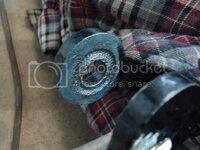
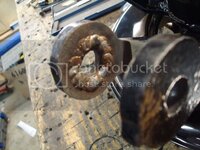
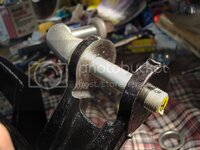



stinger12
Well-known member
- Joined
- Mar 28, 2008
- Messages
- 832
- Reaction score
- 0
Homemade bushing installation tool - it cost me absolutely nothing. I did buy myself a small bench drill press for this project though to add to the collection The flaring tool is made out of an air chisel shank, and the bolt in the center aligns and holds the bushing in place while you flare it. I am going to cut 2 pieces of pipe to put on the long bolts so I know when to stop compressing the rubber. According to Mike dyer, it should be 2.25''.
The flaring tool is made out of an air chisel shank, and the bolt in the center aligns and holds the bushing in place while you flare it. I am going to cut 2 pieces of pipe to put on the long bolts so I know when to stop compressing the rubber. According to Mike dyer, it should be 2.25''.
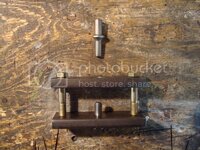

MYBAD79
Moderator
again and again: great job :bounce::bounce::bounce:
Keep posting all these detailed and very helpful threads - thanks for taking the time to re-post all that info here.
Isnt' that bearing support cast ?? What rod did you use to weld it ? Inco ???
Keep posting all these detailed and very helpful threads - thanks for taking the time to re-post all that info here.
Isnt' that bearing support cast ?? What rod did you use to weld it ? Inco ???
stinger12
Well-known member
- Joined
- Mar 28, 2008
- Messages
- 832
- Reaction score
- 0
again and again: great job :bounce::bounce::bounce:
Keep posting all these detailed and very helpful threads - thanks for taking the time to re-post all that info here.
Isnt' that bearing support cast ?? What rod did you use to weld it ? Inco ???
Yes the bearing support is cast iron. I thought it was going to be a bitch to weld due to it being cast iron, but I thought I'd give it a shot after I talked to Mike dyer. He said to slowly work my way around the hole to reduce the amount of heat created and so I could see what I was doing. I used my mig welder, which has a mix of argon/co2 and solid core .030 wire. I also was afraid that the bearings were going to seize up on me, so I kept the ground clamp on the other bearing support ear which is really close to the area I was welding. Worked great.
MYBAD79
Moderator
It is most likely cast steel, not cast iron.... cast iron is pretty much unweldable
stinger12
Well-known member
- Joined
- Mar 28, 2008
- Messages
- 832
- Reaction score
- 0
It is most likely cast steel, not cast iron.... cast iron is pretty much unweldable
You're probably right, which is why it welded so nicely. I doubt i would have been able to weld it if it were cast iron.
MYBAD79
Moderator
what did you weld it with ? regular carbon steel ER70 ?? That's the stuff you buy at the hardware store, higher strength ER90 is not very common, you'll have to get that at a real welding supply store.... Inconell (inco82) is perfect for this, you can pretty much weld anything to anything with inco.... it does however require heat treatment (very slow cooldown) otherwise it's too hard/brittle....
stinger12
Well-known member
- Joined
- Mar 28, 2008
- Messages
- 832
- Reaction score
- 0
what did you weld it with ? regular carbon steel ER70 ?? That's the stuff you buy at the hardware store, higher strength ER90 is not very common, you'll have to get that at a real welding supply store.... Inconell (inco82) is perfect for this, you can pretty much weld anything to anything with inco.... it does however require heat treatment (very slow cooldown) otherwise it's too hard/brittle....
I'm not sure? My uncle, who welds for a living, set me up with my millermatic 175 - its the catz ass for home use. I bought some stuff at a local welding supply house...all I know is that it is solid core 0.030 mig wire. I'll look closer at the spool later on tonight and see what the label says.
stinger12
Well-known member
- Joined
- Mar 28, 2008
- Messages
- 832
- Reaction score
- 0
I found some issues with my offset trailing arms. For some reason, the bushing cups were being pushed out of the tube at the end of the arms. So I pulled them out and decided to remove the bushings out to see what was going on. After I pulled the bushings out, I found some issues with the way they were installed. There was an 1/8'' gap where the cups meet up in the middle. The cups were also not pressed into the piece of pipe on the end of the arm. I decided I wouldn't reinstall poly bushings because they aren't good for this application. This being said, it would require a lot of work to install them correctly.
The first thing I did was remove the powdercoating from the ID of the pipe. I ground down the high spots which were preventing the previous bushing cups from sitting flat on the arm - this was very important, as they would be cocked if you tried to press them in.
Before:

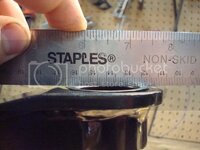
After:
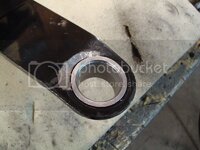
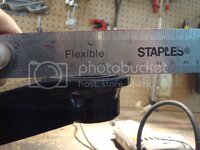
I used my dial caliper to measure how much I had to file the pipe down so that the bushing cups would meet in the middle once they were pressed in. The pipe also wasn't parallel for some reason. The important thing here was to make sure I made the pipe parallel as I filed away metal - this took a lot of time, patience and measuring. I eventually got it to where I wanted it. The next thing I needed to do was open up the bore so that the rubber bushing cups would be a press fit, but they wouldn't be so tight that the rubber wouldn't fit inside them anymore. The hole ID was too tight a press fit for the rubber bushing cups - they wouldn't have seated properly if I just installed them without opening up the bore first. I used my dremel tool and got it the best I could get it. I then pressed the cups into the arm, and the fit was perfect. The cups were really tight in the arm, and they met in the center as opposed to the previous 1/8'' gap I had with the poly bushings.
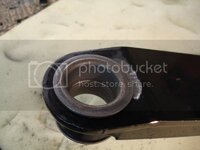
I then used my homemade tool to compress and flare my rubber bushings. I used my press to flare the end of the tube.
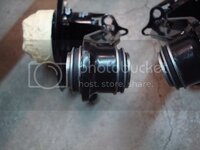

I also decided to install rubber bushings in my strut rods instead of the original poly ones. Rubber is much better for this application. I had to open up the bore on my strut rod ends so that the rubber bushing would be a press fit, but they wouldn't be so tight that the rubber would be oozing out of the ends of the bushings. Again, this took a lot of time, patience and measuring, but I got it done. After I finished this project, I had to clearance my offset arms so they wouldn't hit the pocket or shims. My pockets were in perfect condition, so I don't know why these arm's didn't fit. Basically, I havd to install absolutely everything on the rear end, and do a quick alignment for 1/4'' toe in (which is the worst case scenario for alignment specs), and then check the travel on the arm to see whether or not I needed to clearance them. Sure enough, they hit the pocket, and I had to pull everything apart, clearance the arms, reinstall, and check again. I got very frustrated with the fit of these arms considering that my pockets were in perfect condition. The rear end is almost complete - I just need to get one bolt for the upper shock mount and do one last alignment before I call it good. I bought the correct bolts for the half shaft flanges (the ones with the correct shank on them). I installed them, and twisted two of the french locks. I said screw it, and used loctite with locwashers instead. But when I tried to torque the bolts, the lockwashers kept splitting. I tried everything, then decided to try some brand new bolts to see if the face underneath the heads of my new correct bolts had been galled. Sure enough, my new bolts were the issue. So, I decided to make myself some new ones. I got some 1 3/4'' bolts, which have the smallest shank on them (which was a tiny bit too big, like 1 thread). I cut 1-2 threads extra on the shank just to make sure that it didn't bottom out on the flange when I tightened the bolts. It worked out perfectly. I used red loctite on the thread just to be safe and reinstalled everything successfully. You may have noticed that I didn't install my safety loops. THe reason being is because they get in the way of EVERYTHING. I'll use them on my next vette:lol:
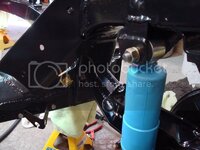 \
\
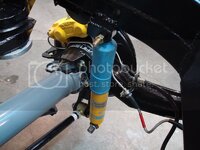
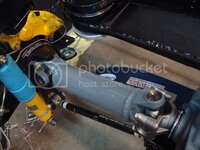
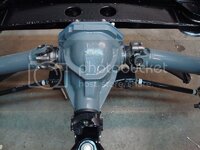
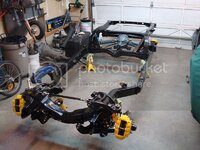
The first thing I did was remove the powdercoating from the ID of the pipe. I ground down the high spots which were preventing the previous bushing cups from sitting flat on the arm - this was very important, as they would be cocked if you tried to press them in.
Before:


After:


I used my dial caliper to measure how much I had to file the pipe down so that the bushing cups would meet in the middle once they were pressed in. The pipe also wasn't parallel for some reason. The important thing here was to make sure I made the pipe parallel as I filed away metal - this took a lot of time, patience and measuring. I eventually got it to where I wanted it. The next thing I needed to do was open up the bore so that the rubber bushing cups would be a press fit, but they wouldn't be so tight that the rubber wouldn't fit inside them anymore. The hole ID was too tight a press fit for the rubber bushing cups - they wouldn't have seated properly if I just installed them without opening up the bore first. I used my dremel tool and got it the best I could get it. I then pressed the cups into the arm, and the fit was perfect. The cups were really tight in the arm, and they met in the center as opposed to the previous 1/8'' gap I had with the poly bushings.

I then used my homemade tool to compress and flare my rubber bushings. I used my press to flare the end of the tube.


I also decided to install rubber bushings in my strut rods instead of the original poly ones. Rubber is much better for this application. I had to open up the bore on my strut rod ends so that the rubber bushing would be a press fit, but they wouldn't be so tight that the rubber would be oozing out of the ends of the bushings. Again, this took a lot of time, patience and measuring, but I got it done. After I finished this project, I had to clearance my offset arms so they wouldn't hit the pocket or shims. My pockets were in perfect condition, so I don't know why these arm's didn't fit. Basically, I havd to install absolutely everything on the rear end, and do a quick alignment for 1/4'' toe in (which is the worst case scenario for alignment specs), and then check the travel on the arm to see whether or not I needed to clearance them. Sure enough, they hit the pocket, and I had to pull everything apart, clearance the arms, reinstall, and check again. I got very frustrated with the fit of these arms considering that my pockets were in perfect condition. The rear end is almost complete - I just need to get one bolt for the upper shock mount and do one last alignment before I call it good. I bought the correct bolts for the half shaft flanges (the ones with the correct shank on them). I installed them, and twisted two of the french locks. I said screw it, and used loctite with locwashers instead. But when I tried to torque the bolts, the lockwashers kept splitting. I tried everything, then decided to try some brand new bolts to see if the face underneath the heads of my new correct bolts had been galled. Sure enough, my new bolts were the issue. So, I decided to make myself some new ones. I got some 1 3/4'' bolts, which have the smallest shank on them (which was a tiny bit too big, like 1 thread). I cut 1-2 threads extra on the shank just to make sure that it didn't bottom out on the flange when I tightened the bolts. It worked out perfectly. I used red loctite on the thread just to be safe and reinstalled everything successfully. You may have noticed that I didn't install my safety loops. THe reason being is because they get in the way of EVERYTHING. I'll use them on my next vette:lol:
 \
\



stinger12
Well-known member
- Joined
- Mar 28, 2008
- Messages
- 832
- Reaction score
- 0
Okay, this has probably been the closest call with these offset arms - I did my rear end alignment today, and I was almost screwed for life...AND THIS IS DEFINITELY NOT DUE TO FRAME POCKET DAMAGE, MY FRAME POCKETS ARE IN PERFECT SHAPE. I aligned the entire rear end with the half shafts level. I dialed in each side for 0 camber and 0 toe in...I was almost on the brink of death with the right side - these arms obviously have some issues with them because they almost didn't fit for 0 toe-in. Maybe the arms were cocked when they were welded, who knows. Anyways, here is how I did it (Mike Dyer taught me this method over the phone...pure genius, thanks Mike:thumbs . It is much more accurate than using a meter stick to do a rough alignment - this method is a thousand times more accurate, because it uses the entire frame rail to dial in the toe-in measurements...not just a tiny section of the frame rail.
. It is much more accurate than using a meter stick to do a rough alignment - this method is a thousand times more accurate, because it uses the entire frame rail to dial in the toe-in measurements...not just a tiny section of the frame rail.
The first thing I did was level off the frame. I used cardboard underneath the jack stands to make the frame perfectly level.


The smart struts are designed to limit camber throughout travel. This can be both a good and a bad thing. I'm not planning on taking this car to the track, just street driving, so limiting the camber would be the way to go in my application. To do this, you need to turn the camber bolts so that they are on the bottom of the slots - the smart strut bracket goes up and down, not left to right like the stock one does. I did the left side first, then I attempted to turn the camber bolts on the right side, and then snap:cuss:banghead:...

The son of a b8tch cracked in half, so the only choice I had left was to use one of my old camber bolts and washers. The original washers are different than the ones that came with my smart struts (they only had one flat on them) So I had to use an entire bolt assembly from my old struts.




Not the best option, but I'm not waiting on stupid parts anymore...nothing ever goes smooth with this stupid rebuild, I'm at my wits end with this project 1 step forward, then 30 steps back. Most of the time its because parts do not fit, and I then have to reengineer them to make them work. Okay now that I have vented, on with the alignment. After you torque the strut rod camber bolts, you are now ready to do the alignment. Take an old rotor and install it backwards on the lug studs...

Raise the arm using a jack underneath the backwards rotor, so that the half shaft is perfectly level - use a small level for this. Once you get the half shaft level, dial in the camber so it is 0 (use a 2 foot level on the rotor pointing up to the roof) - get the bubble centered for zero camber.
Now, tie a piece of string to the area where the spring bolts go, wrap it around the back of the rotor, and then tie it to something heavy that you can move while dialing in the suspension - a jackstand would work well for this application, but I didn't have an extra one, so I just used a bicycle stand I found in the garage.


Now, here is the trick to this method. You want to move the stand you have the string tied to so that it just touches the fact of the rotor. Imagine you are trying to build a fence and this is your plumb line, or a massive ruler if you will. If you placed a meter stick on the face of the rotor, you can measur e the distance to the frame rails in two positions, but these positions would be relatively close together because the meter stick can only reach out so far. The string method allows you to measure an area at the front of the rail, and an area at the rear of the rail, you subtract these two numbers and end up with you spec. Make sure the section of frame rail you are working with is straight. If it isn't, you could always rig something up to the body mount cages to use as a straight line reference point. Contrary to what my pictures show, my frame is not perfect - in fact, the right frame rail had a huge dent in it which I removed and welded in new metal...but it still isn't perfect. So, I had to be careful when I did the toe-in on the right side of the frame, because it is a little "wonky" on the outboard side. Here you can see the two points I chose to measure from while doing the alignment - I used tape to mark them off. You only need two points.

Measurement at the front of the frame rail (after tweaking the trailing arm shims)

Measurement at the rear of the frame rail (after tweaking the trailing arm shims):

You want the measurements at both points to be the same - this means that you have zero toe-in and the rotor is perfectly in line with the chassis' frame. I don't trust alignment shops - I can do it myself and know exactly how well the job was done. Oh, and in regards to what my shims ended up looking like on both sides, here are two pics.
Left Side:

Right Side:

Now you tell me - how lucky was I with the shims on the right side of the frame? I am going to do two more alignments just to make sure I'm safe on the right side, because if it turns out that my measurements were wrong, well then guess what? That means my aftermarket trailing arms were welded incorrectly and they are not straight. If I have to pull this trailing arm off the chassis again, I'm going to go into denial. I suggest you boys stick with the stock arms and avoid the hassle I have gone through with these arms - it just isn't worth it. If I would have known I was going to run into all these issues, I would have stuck with the stock arms...live and learn I guess.
The first thing I did was level off the frame. I used cardboard underneath the jack stands to make the frame perfectly level.


The smart struts are designed to limit camber throughout travel. This can be both a good and a bad thing. I'm not planning on taking this car to the track, just street driving, so limiting the camber would be the way to go in my application. To do this, you need to turn the camber bolts so that they are on the bottom of the slots - the smart strut bracket goes up and down, not left to right like the stock one does. I did the left side first, then I attempted to turn the camber bolts on the right side, and then snap:cuss:banghead:...

The son of a b8tch cracked in half, so the only choice I had left was to use one of my old camber bolts and washers. The original washers are different than the ones that came with my smart struts (they only had one flat on them) So I had to use an entire bolt assembly from my old struts.




Not the best option, but I'm not waiting on stupid parts anymore...nothing ever goes smooth with this stupid rebuild, I'm at my wits end with this project 1 step forward, then 30 steps back. Most of the time its because parts do not fit, and I then have to reengineer them to make them work. Okay now that I have vented, on with the alignment. After you torque the strut rod camber bolts, you are now ready to do the alignment. Take an old rotor and install it backwards on the lug studs...

Raise the arm using a jack underneath the backwards rotor, so that the half shaft is perfectly level - use a small level for this. Once you get the half shaft level, dial in the camber so it is 0 (use a 2 foot level on the rotor pointing up to the roof) - get the bubble centered for zero camber.
Now, tie a piece of string to the area where the spring bolts go, wrap it around the back of the rotor, and then tie it to something heavy that you can move while dialing in the suspension - a jackstand would work well for this application, but I didn't have an extra one, so I just used a bicycle stand I found in the garage.


Now, here is the trick to this method. You want to move the stand you have the string tied to so that it just touches the fact of the rotor. Imagine you are trying to build a fence and this is your plumb line, or a massive ruler if you will. If you placed a meter stick on the face of the rotor, you can measur e the distance to the frame rails in two positions, but these positions would be relatively close together because the meter stick can only reach out so far. The string method allows you to measure an area at the front of the rail, and an area at the rear of the rail, you subtract these two numbers and end up with you spec. Make sure the section of frame rail you are working with is straight. If it isn't, you could always rig something up to the body mount cages to use as a straight line reference point. Contrary to what my pictures show, my frame is not perfect - in fact, the right frame rail had a huge dent in it which I removed and welded in new metal...but it still isn't perfect. So, I had to be careful when I did the toe-in on the right side of the frame, because it is a little "wonky" on the outboard side. Here you can see the two points I chose to measure from while doing the alignment - I used tape to mark them off. You only need two points.

Measurement at the front of the frame rail (after tweaking the trailing arm shims)

Measurement at the rear of the frame rail (after tweaking the trailing arm shims):

You want the measurements at both points to be the same - this means that you have zero toe-in and the rotor is perfectly in line with the chassis' frame. I don't trust alignment shops - I can do it myself and know exactly how well the job was done. Oh, and in regards to what my shims ended up looking like on both sides, here are two pics.
Left Side:

Right Side:

Now you tell me - how lucky was I with the shims on the right side of the frame? I am going to do two more alignments just to make sure I'm safe on the right side, because if it turns out that my measurements were wrong, well then guess what? That means my aftermarket trailing arms were welded incorrectly and they are not straight. If I have to pull this trailing arm off the chassis again, I'm going to go into denial. I suggest you boys stick with the stock arms and avoid the hassle I have gone through with these arms - it just isn't worth it. If I would have known I was going to run into all these issues, I would have stuck with the stock arms...live and learn I guess.
Twin_Turbo
Der Maulwurf
- Joined
- Mar 5, 2008
- Messages
- 7,575
- Reaction score
- 6
With the halfshafts sitting level and setting toe to 0 you are always removing a bunch of shims from the outside because normally in that situation you would have some neg. toe because when the suspension moves away from horizontal, being it up or down it gains more toe out. If you set yours to 0 here you have toe out in every other position, which is a bad idea. Set the toe in, start off with around half a degree or so and adjust to your liking. In the end, your static ride height will most likely not be with level halfshafts so you will have to adjust for that. You really do not want to bump the suspension and go to toe out, it will create massive rear oversteer.
With a stock susp. height (that which the components are designed for) the halfshafts are aiming down, this means that for 0 toe you will have more outboard shims.
If you want to run a slammed ride and not worry about this you have to move the differential up to get the suspension to work around level shafts with a neg. toe setting.
With a stock susp. height (that which the components are designed for) the halfshafts are aiming down, this means that for 0 toe you will have more outboard shims.
If you want to run a slammed ride and not worry about this you have to move the differential up to get the suspension to work around level shafts with a neg. toe setting.
stinger12
Well-known member
- Joined
- Mar 28, 2008
- Messages
- 832
- Reaction score
- 0
With the halfshafts sitting level and setting toe to 0 you are always removing a bunch of shims from the outside because normally in that situation you would have some neg. toe because when the suspension moves away from horizontal, being it up or down it gains more toe out. If you set yours to 0 here you have toe out in every other position, which is a bad idea. Set the toe in, start off with around half a degree or so and adjust to your liking. In the end, your static ride height will most likely not be with level halfshafts so you will have to adjust for that. You really do not want to bump the suspension and go to toe out, it will create massive rear oversteer.
With a stock susp. height (that which the components are designed for) the halfshafts are aiming down, this means that for 0 toe you will have more outboard shims.
If you want to run a slammed ride and not worry about this you have to move the differential up to get the suspension to work around level shafts with a neg. toe setting.
I see what your saying. This is just for now...I will probably be adjusting it once I get weight and tires on the vette.
stinger12
Well-known member
- Joined
- Mar 28, 2008
- Messages
- 832
- Reaction score
- 0
Been busy the past couple weeks - Mike has been helping me design my engine. I only had a magnum 270H cam for my desktop dyno, which is the closest I could find to the crane 272 cam which I will be using. I also only had AFR 190 heads - I'll be using AFR 180's, but it was the closest head file that I had for the program. Here is an overall pic of what I have come up with so far - I am still playing around with it.
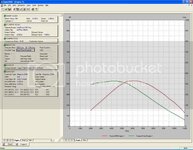

Last edited:
Twin_Turbo
Der Maulwurf
- Joined
- Mar 5, 2008
- Messages
- 7,575
- Reaction score
- 6
You should have checked the downloads section, under engine & perf. there's a zip file with a bunch of dd2k head files, amongst them is.... sbc air flow research 180cc.flw

